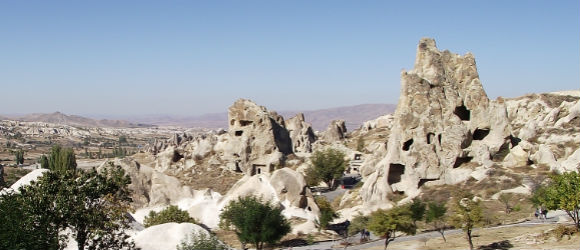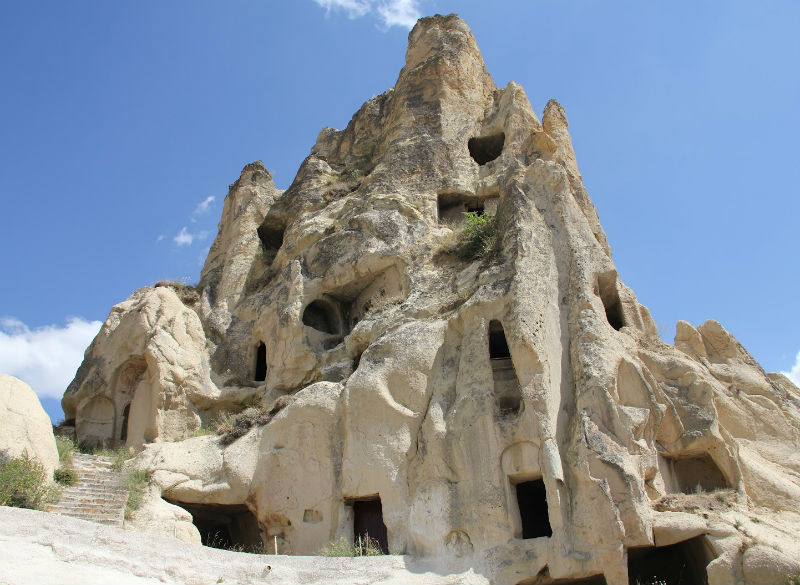The 6-7 storey rock mass to the left of the museum entrance is known as “the Nunnery“. The dining hall, kitchen and some rooms on the first floor, together with the ruined chapel on the second level, can still be visited. The church on the third storey, which can be reached through a tunnel, has a cruciform plan, a dome with four columns and three apses. The templon on the main apse is rarely found in Goreme’s churches. Besides the fresco of Jesus, painted directly onto the rock, designs painted in red can also be seen. The different levels of the monastery are connected by tunnels, and “millstone doors”, such as those found in the underground cities, and were used to close off these tunnels in times of danger.
For the whole list of inscribed-cross churches in Cappadocia. There are also a number of small 11th century chapels on an inscribed-cross plan with a dome, in which the carefully wrought paintings found elsewhere give place to simple linear drawings and images of Christ and various saints enclosed in frames like icons. At present, however, many of them are closed to public.
Chapel 17 is an inscribed-cross church with a central dome. A tiny dome is carried on very wide barrel-vaulted arms and columns, there are four thick columns with tapering block capitals. The church shows capitals with an abacus “The cross-arms are barrel vaulted.
The northeast corner bay has a flat ceiling; the other three are covered by calottes. Blind niches decorate the walls of the four corner bays. The church has a rectangular narthex with a barrel vault.
Before entering to the naos, there is a rectangular narthex with a barrel vault. There are three apses. The central one closed by a tall screen, with a central horseshoe-arched entrance flanked by small horseshoe-arched openings. Above these, there are two more such openings and above the entrance, a small
horseshoe-arched lunette and a larger lunette open above the top of the screen. The later apses have narrow chancel slabs (Rodley 1985, 182). Kızlar Church contains a completely preserved iconostasis decorated with cross reliefs and polychrome, in its decoration programme, the linear painting is noteworthy. The columns are painted red. On the north wall of the north cross arm, there is a picture of Christ standing and holding the Holy Book in his left hand while giving a blessing with his right apart from the picture of Christ, there are a number could not see the church for the same reason, of dated graffiti, especially on the front left-hand column. These have been scratched into the red paint of the column and linear decoration, but they have no reference to the depiction of Christ. In the invocations the years 1055, 1058, 1065, 1074, and 1129 are mentioned. In the last date the two middle figures are now unreadable.
Saint Macrina the Younger (c.330– 19 July 379) was born at Caesarea, Cappadocia. Her parents were Basil the Elder and Emmelia, and her grandmother was Saint Macrina the Elder. Among her nine siblings were two of the three Cappadocian Fathers, her younger brothers Basil the Great and Saint Gregory of Nyssa, as well as Peter of Sebaste. Her father arranged for her to marry but her fiance died before the wedding. She devoted herself to her religion, becoming a nun.
She became well known as a holy woman and instructed many young women religiously. For this she is honored as one of the most prominent nuns of the Eastern Church. She had a profound influence upon her brothers with her adherence to an ascetic ideal. Her brother Gregory of Nyssa wrote a work entitled Life of Macrina in which he describes her sancity throughout her life. In 379, Macrina died at her family’s estate in Pontus, which with the help of her younger brother Peter she had turned into a monastery and convent. Gregory of Nyssa composed a “Dialogue on the Soul and Resurrection” (peri psyches kai anastaseos), entitled ta Makrinia (P.G. XLVI, 12 sq.), to commemorate Macrina. Her feast day is the 19 July.
Universalists, including Hosea Ballou and J. W. Hanson, claim Macrina as a Universalist in her teachings, citing works which they believe demonstrate Macrina’s belief that the wicked in purgatory would all eventually confess Christ.
From a Nun’s Convent to Biblical Conversion
Jacqueline Kassar
Fortyfive years of my life were spent as a Roman Catholic, twenty two of them as a nun in an enclosed convent dedicated to adoration, reparation and suffering. I believed it was a nun’s calling to be a miniature savior of the world like Jesus Christ.
My Decision to be a Nun After attending Catholic elementary school for eight years and memorizing catechism, which is the Roman Catholic textbook, I believed in my heart that a family having a son or daughter become a priest or nun would receive God’s favor and special blessings. I decided to enter the convent when I was old enough to leave home. This was my goal while I was still in my teens. On my twentyfirst birthday,
1954, I entered the convent against my parent’s wishes. My belief in my calling to be a nun superseded my parent’s vehement opposition.
Even though it broke my heart to leave my parents, I consoled myself in the fact that I was doing God’s will by making this sacrifice for the salvation of my family and all those outside the Catholic faith who I believed were doomed to hell.
Convent Life
At first, I was in awe of the solitude, structural beauty and peacefulness the convent seemed to have. I was taught to do penances such as sleeping on a board, prostrating myself at the door of the dining room as an act of humiliation and beating myself as a means of appeasing God’s wrath. This taught me to believe in a punishing, unapproachable and unloving God. I feared Him at every turn of my life.
As time went on, emptiness filled my heart and hopelessness engulfed me. I became depressed, often crying while I raged with anger at authority and hatred for the rules and customs in the convent that were so very cruel. My body developed all kinds of illnesses and I found myself with a tremor that only Valium could help. All the time the medication was dulling my mind and taking away my ability to think and reason.
Nunnery and Monastery,




Nunnery and Monastery just like the underground cities the sections have dining halls, kitchens, living and sleeping rooms, storage parts and churches for the nuns and monks.
Loved this museum with all it’s little caves, churches, Nunnery and Monastery in the stunning landscape. We got the audio tour and it gave us all the information we needed. We did get to one section after paying the entry fee and to enter that particular section you had to pay another fee which annoyed us a bit. We didn’t bother as there was enough to see anyway.
The 6-7 storey rock mass to the left of the museum entrance is known as the “Nunnery”. The dining hall, kitchen and some rooms on the first floor, together with the ruined chapel on the second level, can still be visited.